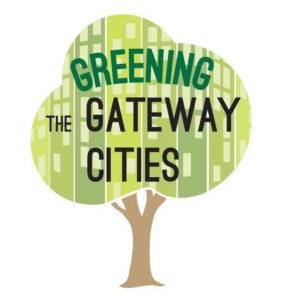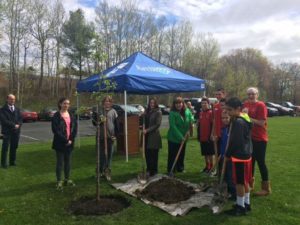
The Massachusetts Greening the Gateway Cities Program (GGCP) is an environmental and energy efficiency program designed to reduce household heating and cooling energy use by increasing tree canopy cover in urban residential areas in the state’s Gateway Cities. GGCP is a partnership between the Executive Office of Energy and Environmental Affairs (EEA), the Department of Conservation and Recreation (DCR) Urban & Community Forestry Program, the Department of Energy Resources (DOER) and the Department of Housing and Community Development (DHCD), along with Gateway Cities and local grassroots organizations.
In Pittsfield, MA, BEAT is the lead local grassroots organization helping with outreach and helping to water the many young trees planted in the public housing areas of Pittsfield. These trees will not only help lower the energy use in our public housing areas, but make them more attractive areas to live and play.

Photo of ceremony at Reid Middle School with Mayor Linds Tyer & Representative Tricia Farley-Bouvier
The program plants trees (ranging from 6ft to l0ft tall) with a goal of covering 5-10% of the target neighborhoods in new tree canopy cover. Trees are planted by DCR Bureau of Forestry, Urban & Community Forestry crews hired from local communities.
GGCP is based on current research, which includes on-the-ground tree and energy measurements in Worcester and other northern climate cities. These studies show that tree canopy brings the greatest benefits when established over an entire neighborhood area, by lowering wind speeds and reducing summertime air temperature, in addition to the benefits of direct shading. It is estimated that every l% increase in tree canopy above a minimum 10% canopy cover brings a 1.9% reduction in energy needs for cooling and up to a 1.1% reduction in energy for heating. All households in a neighborhood benefit, not just the ones with trees directly adjacent.
This program targets the parts of Gateway Cities that have lower tree canopy, older housing stock, higher wind speeds, and a larger renter population. In addition, plantings are concentrated in Environmental Justice Neighborhoods, to benefit those most in need. Within planted areas temperature, energy use, and other information is tracked to document the energy savings new trees provide residents over time. Pilot cities in which this monitoring is taking place include Chelsea, Fall River and Holyoke.
Neighborhood Level Tree Canopy Cover is Important
Concentrating tree plantings in target areas maximizes energy savings. Trees near a home directly shade structures, significantly lowering surface temperatures, while trees up to 1,500 feet away from a home still provide a benefit. Program goals are to plant 10 trees per acre, which will reduce the Urban Heat Island effect, and decrease summer air temperatures in city neighborhoods through shading and increased transpiration. Additionally, in the winter months, mature tree trunks and branches help to randomize wind patterns and decrease heat loss by air infiltration in poorly insulated homes.
In high-density urban neighborhoods, planting an average of 5-10 trees per acre (roughly one third of a block) will provide benefits to 15 – 25 households, depending on building density. Most trees are planted in yards where they grow quickly with the care provided by residents. Planting this number of trees will increase canopy by an estimated 1% in eight years, and l0% in 30 years. Return on investment is realized in 15 years, after which additional energy savings are realized for the life of the trees.
Back to Pittsfield’s Greening the Gateway City page
